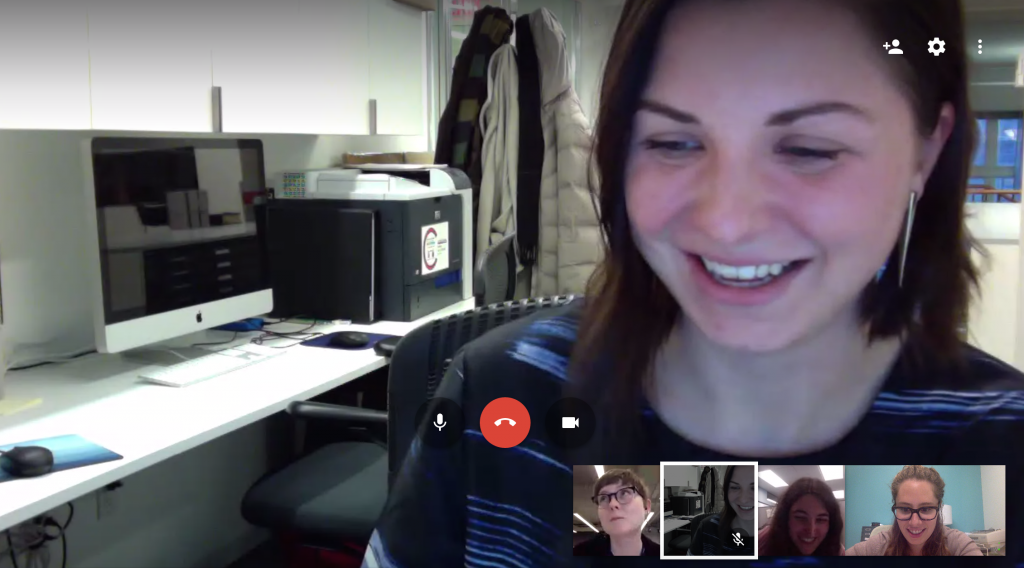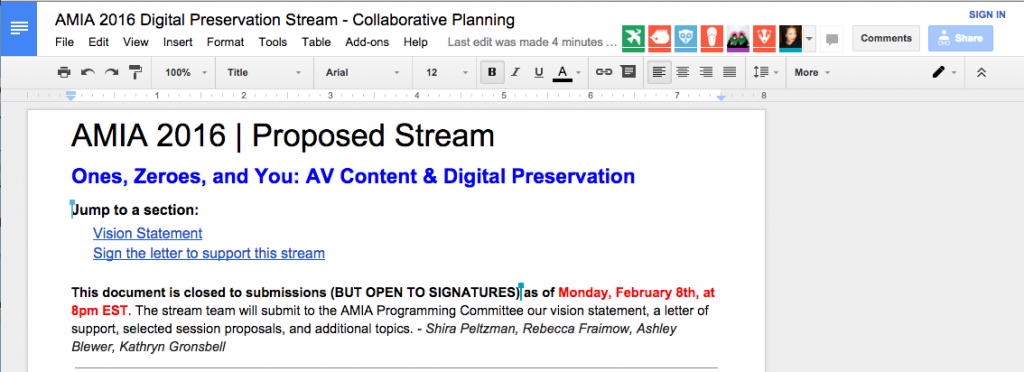The following is a guest post by Kathryn Gronsbell, Digital Asset Manager, Carnegie Hall; Shira Peltzman, Digital Archivist, UCLA Library; Ashley Blewer, Applications Developer, NYPL; and Rebecca Fraimow, Archivist and AAPB NDSR Program Coordinator, WGBH.
The intersection of digital preservation and audiovisual archiving has reached a tipping point. As the media production and use landscape evolves, so too have preservation strategies. From the rapid improvements in digital capture technology, to the adoption of file-based production workflows and digital distribution technology, to storage that has increased in capacity and decreased in price, to the widespread use of cloud-based storage solutions, over the past decade we have witnessed a series of transformations that fundamentally alter dominant theories and practices of moving image preservation and access.

A candid snapshot of a remote meeting with (top) Kathryn, (left to right) Ashley, Rebecca, and Shira discussing the proposed stream.
To generate conversation around this shifting terrain, we spent one month creating a collaborative proposal for a stream of sessions at the annual Association of Moving Image Archivists (AMIA) conference. Although there have been talks at past AMIA conferences that have addressed aspects of digital preservation, AMIA’s recent transition to a stream-based programming model provided us with a unique and valuable opportunity to discuss this topic in greater depth and length.
The stream we proposed focuses on questions, challenges, and benefits related to the intersection of audiovisual content and digital preservation. We asked a wide range of stakeholders with an interest in digital preservation and/or moving image archiving to propose sessions, sign a letter of support (which garnered nearly 180 signatures from organizations across five different continents as of February 15th), and add topics that would benefit the A/V community. Our initial proposal included:
- Digital preservation in practice (strategies)
- How to preserve: sharing, learning, and building collaboratively (innovation and practical engagement)
- Dissolving boundaries: the necessity of multi-disciplinary input for preservation (borrow and steal from people smarter than us)
- Transitioning from a short-term digital preservation project to a long-term program (sustainability)
Submissions for additional sessions and talk proposals began to come in as soon as we opened the document for public comment and contributions. We received contributions from A/V archivists, digital asset managers, conservation and preservation specialists, and academics from across library, archive, museum, gallery, government, and broadcast industries. As we expected, contributors addressed conceptual and practical conversations — everything from hands-on technologies to workflows to ISO standards. During the two-week period the document was open, our initial list of topics ballooned to 10+ session proposals.
The wholesale acceptance of digital preservation has been slower within the moving image archiving and preservation community than in adjacent fields, and events focused on digital preservation rarely delve deeply into the challenges presented by audiovisual materials. Acceptance may be slower in the moving image community because individuals must devote resources to advocating and managing their physical collections, which are frequently segregated from larger, strategic initiatives (even within a single organization) due to the cost and complexity of preserving analog film/video content. The shifting focus towards digital preservation is an opportunity to dissolve the manufactured boundary between A/V and still image (or other) content and include audiovisual specialists in broader discussions of preservation and access. For us, the broad-based support that our stream proposal received has been a clear indicator of both a pressing need and collective desire to address some of the practical, theoretical, and ontological questions that digital preservation raises for some of our colleagues. What we’re hoping to achieve with this proposed stream is–at least in part–to demonstrate that although audiovisual and other complex materials (e.g. software) may require special attention, the basics are already well understood and championed by other communities where expertise in this area is profound: data storage research, all forms of computer sciences, information and knowledge management, emulation and migration specialists, and research repositories have a deep history in long-term data preservation. We can also learn from efforts in adjacent fields, like financial data security, and tweak their lessons learned to our needs and resources. Increasing the engagement of the analog film and video world with the digital preservation community, and vice versa, will yield tremendous benefits on both sides of the divide.
Integrating digital preservation activities into A/V preservation and increasing digital literacy across the field is integral to the field’s continued success and relevance. There have been some important gains in this area in recent years, including:
- AMIA/DLF co-sponsored Hack Days
- AMIA Open Source Committee and the The Open Source Digital Preservation and Access Stream from the 2014 AMIA conference
- Lightweight introduction panels to digital preservation concepts and software in previous AMIA conferences and programming alternatives dedicated to digital asset management
- The voluntary engagement of individual AV professionals in professional organizations and training that focus on digital preservation
By proposing a stream that is dedicated to the intersection of digital preservation and audiovisual archiving, we’re hoping to break down any the barriers to knowledge that may still exist so that digital preservation may be widely understood as a core competency in the A/V archiving field, rather than as a topic that gets pushed to the perimeter. Hopefully this will allow archiving community to become part of a wider conversation about digital preservation across disciplines.
Our community-based solicitation approach (via cloud-based shared documents) mirrors the need for more voices in digital preservation conversation (across fields, communities, specialties — no more operation in silos!). By providing alternate entry into a dedicated discussion of digital preservation, we welcome organizations and individuals who have limited resources or haven’t started strategically thinking about digital preservation — and feel out-of-place or unwelcome in “specialized” discussions spaces like NDSA regional/national meetings, iPRES, PASIG, DPC etc. We want to bring digital preservation discussion into a comfortable space for AV folks — somewhere like AMIA — where the community can dip its toes in without feeling lost in a wave of information. In the next month alone, there are many opportunities (for example, the listings on the DLF’s Community Calendar) where A/V professionals can participate to share their expertise in broader conversations.
We look forward to more visibility of the intersection between audiovisual preservation and digital preservation, and are excited to continue the developing conversation between these two fields.

